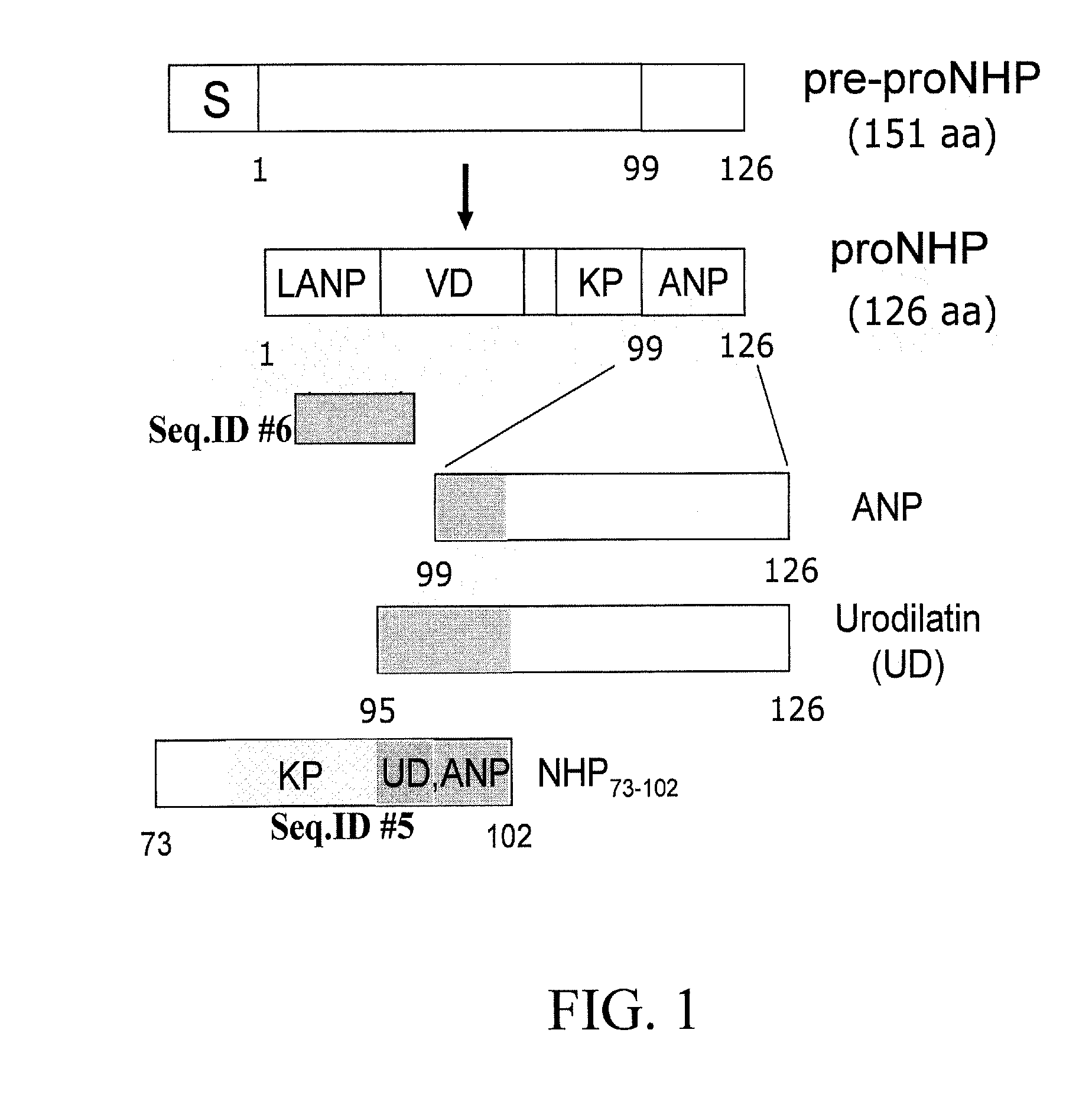Materials and Methods for Treatment of Allergic Diseases
a technology for allergic diseases and materials, applied in the field of materials and methods for treating allergic diseases, can solve the problems of limiting the use of long-term modulation of airway hyper-responsiveness, possessing other significant adverse effects, and short half-life, and achieves the effect of inhibiting allergen-specific ige synthesis
- Summary
- Abstract
- Description
- Claims
- Application Information
AI Technical Summary
Benefits of technology
Problems solved by technology
Method used
Image
Examples
example 1
Expression of NHP in Human Type-II Alveolar A549 Cells and Murine Lung
[0092] A. Materials and Methods
[0093] Animals. Six-week old female BALB / c mice from Jackson laboratory (Bar Harbor, Me.) were maintained in pathogen free conditions in accordance with animal research committee regulations.
[0094] Construction of NHP expression vector. Total RNA was isolated from murine heart using Trizol reagent (LIFE TECHNOLOGY, Gaithersburg, Md.) following the manufacturer's protocol. The cDNA sequence for the 151 amino acid long pre-pro hormone ANF was amplified by RT-PCR. SEQ ID NO:13 was amplified using primers listed in SEQ ID NO:8 and SEQ ID NO:9. NHP73-102 was amplified using primers listed in SEQ ID NO:10 and SEQ ID NO:11. A translation initiation codon was inserted in the forward primers (SEQ ID NO:8 and SEQ ID NO:10), so that the recombinant peptides had an additional amino acid, methionine, as the first amino acid apart from its known amino acid content. The PCR product was cloned in...
example 2
pNHP Delivered with Lipofectin Intranasally Attenuates Airway Reactivity in Ovalbumin-Sensitized Mice
[0098] A. Materials and Methods
[0099] Animals. Six-week old female BALB / c mice from Jackson laboratory (Bar Harbor, Me.) were maintained in pathogen free conditions in accordance with animal research committee regulations.
[0100] Allergen Sensitization, Intranasal Gene Transfer. BALB / c mice (n=6) were sensitized once with intraperitoneal (i.p.) injection of 10 μg ovalbumin (OVA) precipitated with 1 mg of alum on day 1. Mice were intranasaly (i.n.) administered three times a day with either 25 μg / mouse pNHP73-102 or vector control (pVAX) (10 μg of lipofectamine in PBS) on days 15, 18 and 21, as shown in FIG. 3A.
[0101] RT-PCR analysis. Total RNA was isolated from murine lung and spleen tissue using Trizol reagent (LIFE TECHNOLOGY, Gaithersburg, Md.) and RT-PCR was performed utilizing ANP specific primers as described before (Kumar M. et al., Vaccine 1999; 18:558-567). The resultant ...
example 3
Chitosan-pNHP Nanoparticles Administered Intranasally Decrease Airway Hyper-Reactivity and Inflammation
[0110] A. Materials and Methods
[0111] Animals. Female 6 to 8 week-old wild type BALB / c mice from Jackson Laboratory (Bar Harbor, Me.) were maintained in pathogen-free conditions at the University of South Florida College of Medicine vivarium. All procedures were reviewed and approved by the committees on animal research at the University of South Florida College of Medicine and VA Hospital.
[0112] Preparation of chitosan-pNHP nanoparticles. pNHP73-102 encoding DNA was cloned in the mammalian expression vector pVAX (INVITROGEN, San Diego, Calif.), and complexed with chitosan, as described previously (Hulks, G. et al., Clin Sci, 1990, 79:51-55; Angus, R. M. et al., Clin Exp Allergy, 1994, 24:784-788). Briefly, recombinant plasmid dissolved in 25 mM Na2SO4 was heated for 10 min at 55° C. Chitosan (VANSON, Redmond, Wash.) was dissolved in 25 mM Na acetate, pH 5.4, to a final concentr...
PUM
| Property | Measurement | Unit |
|---|---|---|
| concentration | aaaaa | aaaaa |
| size | aaaaa | aaaaa |
| temperature | aaaaa | aaaaa |
Abstract
Description
Claims
Application Information
 Login to View More
Login to View More - R&D
- Intellectual Property
- Life Sciences
- Materials
- Tech Scout
- Unparalleled Data Quality
- Higher Quality Content
- 60% Fewer Hallucinations
Browse by: Latest US Patents, China's latest patents, Technical Efficacy Thesaurus, Application Domain, Technology Topic, Popular Technical Reports.
© 2025 PatSnap. All rights reserved.Legal|Privacy policy|Modern Slavery Act Transparency Statement|Sitemap|About US| Contact US: help@patsnap.com



